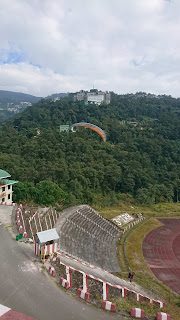Addendum
Addendum...
The population of Sikkim is a grand fusion of diverse communities, cultures, religions and customs. It is a fine specimen of harmony between people from different areas and regions. In Sikkim, there are three leading communties and they are the Lepchas, the Bhutias and the Nepalese. Due to the developmental activities migrant labourers from the plains and Nepal are also found.
The Lepchas
The Lepchas are said to be the original inhabitants of Sikkim. They date back to even before the migration of the Bhutias and the Nepalese. The original Lepchas were believers of the bone faith or mune faith. The faith was essentially based on spirits, good and bad. They used to worship spirits of mountains, rivers and forests. Perhaps, this could be the reason why people of Sikkim have an acute enviroment awareness and a keen sense of healthy living. Lepchas are known for their archery skills.
The Bhutias
 The Bhutias are people of Tibetan origin their migration dating back to 15th century. The northern part of Sikkim is basically their base. These people speak 'Sikkimese' language. In comparison, the Bhutias dominate large
The Bhutias are people of Tibetan origin their migration dating back to 15th century. The northern part of Sikkim is basically their base. These people speak 'Sikkimese' language. In comparison, the Bhutias dominate large
number of villages than Lepchas. The rectangular shaped house of a Bhutia is known as 'Khin'.
Credit of this picture goes to the original uploader
The Nepalese
In Sikkim, the Nepalese came long after the Lepchas and Bhutias. They migrated to Sikkim in hordes rapidly, emerging as the leading community. At present, its 67% of the total population of Sikkim. These people commenced terrace farming in the state. Cardamom was cultivated by the Nepalese and their output has made India the second largest producer. The Nepalese are sub-divided into various castes and tribes like Bawans (Brahmans), Chhetries, Gurungs, Tamangs, Rais, Limbus, Magars, Damais, Kamis etc. Majority are Hindus but Buddhism is also practiced. They speak Nepali, very similar to Hindi.
Among the Buddhists in Sikkim, there are both who follow the Guru Padma Sambhava, Mahayana and the Dalai Lama, Tibetean Tantric Buddhism...
Sikkim, one of the cleanest and the greenest north-eastern states is keen to not just preserve its forest cover, but also forge amity between people and trees. A recent Government notification allows a person to adopt or preserve trees in remembrance of a departed relative. It is allowed in three ways.
~~~ oOo ~~~
There are still a few more places in Sikkim where I didn't set foot as its best in May/June with the Yumthang Valley transforming itself into the Valley of Flowers...
This trip of mine came about with a help of a good friend of mine, Meena Stephen of Taanya Tours and Travels, Chennai, who has always stitched my requirements together and brought about a perfect tailor-made one for me...
Thank you all for being with me and hope to see you all next time too... Au revoir
Pawan...Here it is..to quench your thirst.
The population of Sikkim is a grand fusion of diverse communities, cultures, religions and customs. It is a fine specimen of harmony between people from different areas and regions. In Sikkim, there are three leading communties and they are the Lepchas, the Bhutias and the Nepalese. Due to the developmental activities migrant labourers from the plains and Nepal are also found.
The Lepchas
The Lepchas are said to be the original inhabitants of Sikkim. They date back to even before the migration of the Bhutias and the Nepalese. The original Lepchas were believers of the bone faith or mune faith. The faith was essentially based on spirits, good and bad. They used to worship spirits of mountains, rivers and forests. Perhaps, this could be the reason why people of Sikkim have an acute enviroment awareness and a keen sense of healthy living. Lepchas are known for their archery skills.
The Bhutias
 The Bhutias are people of Tibetan origin their migration dating back to 15th century. The northern part of Sikkim is basically their base. These people speak 'Sikkimese' language. In comparison, the Bhutias dominate large
The Bhutias are people of Tibetan origin their migration dating back to 15th century. The northern part of Sikkim is basically their base. These people speak 'Sikkimese' language. In comparison, the Bhutias dominate large number of villages than Lepchas. The rectangular shaped house of a Bhutia is known as 'Khin'.
Credit of this picture goes to the original uploader
The Nepalese
In Sikkim, the Nepalese came long after the Lepchas and Bhutias. They migrated to Sikkim in hordes rapidly, emerging as the leading community. At present, its 67% of the total population of Sikkim. These people commenced terrace farming in the state. Cardamom was cultivated by the Nepalese and their output has made India the second largest producer. The Nepalese are sub-divided into various castes and tribes like Bawans (Brahmans), Chhetries, Gurungs, Tamangs, Rais, Limbus, Magars, Damais, Kamis etc. Majority are Hindus but Buddhism is also practiced. They speak Nepali, very similar to Hindi.
Among the Buddhists in Sikkim, there are both who follow the Guru Padma Sambhava, Mahayana and the Dalai Lama, Tibetean Tantric Buddhism...
Sikkim, one of the cleanest and the greenest north-eastern states is keen to not just preserve its forest cover, but also forge amity between people and trees. A recent Government notification allows a person to adopt or preserve trees in remembrance of a departed relative. It is allowed in three ways.
One... People are encouraged to forge a relationship of brotherhood / sisterhood by a practice known as mith or mithini
Two...People are encouraged to adopt a tree and it is recorded as adopted and entered into the family register.
Three...People are allowed to preserve a tree in remembrance of a departed relative in which case the tree shall be called a smriti tree
~~~ oOo ~~~
What I noticed about these people is they are genial. They are sticklers to rules. They are ever helping and don't expect more than what is already decided... Felt the impact of Ministry of Tourism's tagline...Athithi Devobhava... Guest is equivalent to God... the host-guest relationship as per ancient Hindu scriptures. They bend backwards and oblige... of course the guest needs to be reasonable too... ~~~ oOo ~~~
~~~ oOo ~~~
There are still a few more places in Sikkim where I didn't set foot as its best in May/June with the Yumthang Valley transforming itself into the Valley of Flowers...
This trip of mine came about with a help of a good friend of mine, Meena Stephen of Taanya Tours and Travels, Chennai, who has always stitched my requirements together and brought about a perfect tailor-made one for me...
Thank you all for being with me and hope to see you all next time too... Au revoir




Comments
Post a Comment